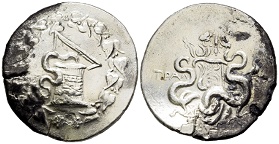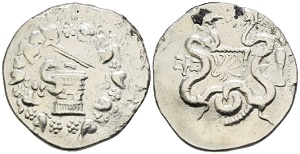Fine Coins Showcase
Antiquities Showcase
Hide empty categories
Shop Search
Shopping Cart
My FORVM
Contact Us
About Forum
Shopping at Forum
Our Guarantee
Payment Options
Shipping Options & Fees
Privacy & Security
Forum Staff
Selling Your Coins
Identifying Your Coin
FAQs
zoom.asp
Home ▸ Catalog ▸ |Themes & Provenance| ▸ |Denominations| ▸ |Cistophori||View Options:   | | | | | | The cistophorus was introduced at Pergamon sometime between 200 and 160 B.C. to provide the Attalid kingdom with a substitute for Seleucid coins and the tetradrachms of Philetairos. The denomination was also struck by other cities under Attalid control. The denomination owes its name to cista mystica, the sacred chest of Dionysus, on the obverse. It was valued at four drachms but weighed only 12.75 grams, as much as three Attic drachms (the most important weight standard of the time). Hoard evidence suggests that they did not travel outside the area which Pergamon controlled, indicating they were valued higher within that area. Cistophori continued to be minted and circulated down to the time of Hadrian, long after the kingdom was bequeathed to Rome in 133 B.C. The portrait of Augustus and later emperors replaced the cista on the obverse. |



In 30/29 B.C., the Koinon of Asia and Bithynia requested permission to honor the Augustus as a living god. "Republican" Rome despised the worship of a living man, but an outright refusal might offend their loyal allies. A cautious formula was drawn up, non-Romans could establish cults and build temples for divus Augustus jointly with dea Roma. Communitas Asiae (Community of Asia) was pro-consular Roman province comprised of Lydia, Iconia, Caria, Mysia, Phrygia, and Hellespontus.SL113456. Silver cistophorus, RPC Online I 2221, RIC I 120 (R3, Pergamon), RSC II 3, BMCRE I 228, SRCV I 1838, NGC F, strike 5/5, surface 3/5 (2400265-002), weight 10.53 g, maximum diameter 26 mm, die axis 180o, probably Ephesos (near Selçuk, Turkey) mint, 41 - 42 A.D.; obverse TI CLAVD CAES AVG, bare head left; reverse Temple of Roma and Augustus, two columns, podium with four steps, within temple Augustus and Roma stand facing, Augustus in military garb with spear in right hand and shield in left, Fortuna crowns him with wreath in right hand and holds cornucopia in left hand, ROM ET AVG (Roma and Augustus) on entablature, COM - ASI (Communitas Asiae) across field at center; from a Virginia Collector, ex Eastern Numismatics Inc. (Garden City, NY, 17 Jan 2013, $1695); NGC| Lookup; very rare; $1530.00 (€1438.20)
Tralleis, Lydia, Cistophoric Coinage Under Attalid Rule, c. 140 - 135 B.C.


On the slopes of Mount Messogis in the valley of the Meander, Tralles, was one of the largest and richest cities of Lydia. King Attalus had a splendid palace there. The local god was Zeus Larasios, but Apollo Pythius and other divinities were also worshiped. Tralles was destroyed by an earthquake but was rebuilt by Augustus and took the name of Caesarea.
The cista mystica was a basket used for housing sacred snakes in connection with the initiation ceremony into the cult of Bacchus (Dionysus). In the Dionysian mysteries a snake, representing the god and possibly symbolic of his phallus, was carried in a cista mystica on a bed of vine leaves.
From pages 73-74 of Kleiner-Noe: "In Series 40, the chief and subsidiary symbols are eagle and fulmen respectively, both attributes of Zeus Larasius and commonly used on the coinage of Tralles; the monogram [...] must refer to the official who also signs as ΔΙΟΓΕ." The "must" was undoubtedly added here by Kleiner on account of the fact that the obverse die used in striking our coin was also paired with at least one of the ΔΙΟΓΕ marked reverses. A rare confirmation of a rather complex Greek monogram!GS114887. Silver cistophoric tetradrachm, Kleiner-Noe Series 40 (17 spec.; obv. die 72); SNG Cop 650; SNGvA 3256; SNG Fitzwilliam VI 4898; SNG Berry II 1146; BMC Lydia p. 329, 28, VF, flan cracks, partly covered in thick black tarnish on one side (hoard patina?), surfaces otherwise lightly toned and smooth, weight 11.445 g, maximum diameter 29.3 mm, die axis 0o, Tralleis (Aydýn, Turkey) mint, c. 140 - 135 B.C., magistrate Dioge(nes?); obverse snake emerging from a cista mystica with half-open lid, all within ivy wreath; reverse two coiling snakes, heads erect, around bow in ornamented bow-case, vertical fulmen above center, TPAΛ (Tralleis) horizontal at center left, eagle standing right at center right, ΔIOΓE monogram (magistrate) low inner left; $200.00 (€188.00)
Ephesos, Ionia, Cistophoric Coinage Under Attalid Rule, c. 160 - 150 B.C.


In his 1979 ANSMN article, "Some Reflections on the Early Cistophoric Coinage," which was a critique of the 1977 Kleiner-Noe monograph, Otto Mørkholm writes: "The old notion that Ephesus was the most important cistophoric mint and that the coinage originated there are shown to be wrong. It was only after 134/3 B.C. that Ephesus became the most prolific cistophoric mint. The huge production of the years 134/3 to 129/8 B.C., demanding 45 obverse dies in six years, was undoubtedly a result of Ephesus' position as a military headquarters in the fighting against Aristonicus."GS114886. Silver cistophoric tetradrachm, Kleiner-Noe Series 13 (13 spec.); SNG Cop. 305; SNGvA 1852; BMC Ionia, p. 63, 143, Pinder 19, aVF, lightly toned, decent centering, and smooth surfaces with two small spots of horn silver on rev., weight 11.338 g, maximum diameter 28.6 mm, die axis 0o, Ephesos (near Selcuk, Turkey) mint, c. 160 - 150 B.C.; obverse snake emerging from a cista mystica with half-open lid, all within ivy wreath; reverse bow in ornamented bow-case between two coiling snakes, heads erect, ΕΦΕ horizontal on center left, cult statue of Artemis Ephesia standing facing on center right; $150.00 (€141.00)
Amisos, Pontos, c. 85 - 65 B.C.


Amisos was a rich commercial center under the kings of Pontus, a royal residence and fortress of Mithridates, and was the home of the fabled Amazons.GB113960. Bronze AE 21, cf. SNG BM 1200; BMC Pontus, p. 17, 52; Rec Gen p. 65, 24; SGCV II 3640; HGC 7 243; SNG Stancomb -; SNGvA -, VF, green patina, tight flan, weight 7.324 g, maximum diameter 20.5 mm, die axis 0o, Amisos (Samsun, Turkey) mint, c. 85 - 65 B.C.; obverse head of Dionysos right (with the features of Mithradates VI?), wearing ivy-wreath; reverse cista mystica, on which rests panther skin and thyrsos, AMIΣOY below, no monogram; $100.00 (€94.00)
Augustus, 16 January 27 B.C. - 19 August 14 A.D.


The cistophorus was first struck by the Pergamene Kingdom was a tetradrachm (four-drachms coin) struck on a reduced Asian standard of about 3 grams per drachm. Its name was derived from the cista, a Dionysian cult snake basket that frequently appeared on the obverse. After the Pergamene Kingdom was bequeathed to Rome in 133 B.C., the Romans continued to strike cistophori for the Asia province, with a value equal to three denarii. The portrait of Augustus and later emperors replaced the cista on the obverse.SH85435. Silver cistophoric tetradrachm, Sutherland Group VI, RPC I 2213, RSC I 16, RIC I 477, BnF I 916, BMCRE I 696, BMCRR East 263, SRCV I -, VF, well centered, toned, light marks and scratches, weight 11.796 g, maximum diameter 26.0 mm, die axis 30o, Ephesus mint, c. 25 - 20 B.C.; obverse IMP CAE-SAR (counterclockwise below), bare head right, linear border; reverse capricorn right, head turned back left, cornucopia on its back, AVGVSTVS below, all within laurel wreath; SOLD
Julia Titi, Augusta c. 79 - 89 A.D. Ephesos Ionia, Ancient Counterfeit


Julia Titi was the daughter of the Emperor Titus, and although married, she had an affair with her uncle Domitian. In 83 A.D., Domitian divorced his wife and lived openly with her. It has been said that she died because Domitian forced her to have an abortion but modern research indicates this allegation is false.RS94294. Fouree silver plated cistophorus, cf. RIC II-1 p. 330, D848, RPC II 871, BMCRE 258 (official prototype, solid silver, very rare), F, gaps in silver plate, scratches, potentially active corrosion, weight 9.560 g, maximum diameter 25.5 mm, die axis 180o, unofficial counterfeiter's mint, 81 - 90 A.D.; obverse IVLIA AVGVSTA DIVI TITI F, draped bust right, hair in a knot in back; reverse Vesta seated left, palladium in right hand, scepter in left hand, VESTA in exergue; SOLD
CLICK HERE TO SEE MORE FROM THIS CATEGORY - FORVM's PRIOR SALES



REFERENCES|
Page created in 1.125 seconds.








